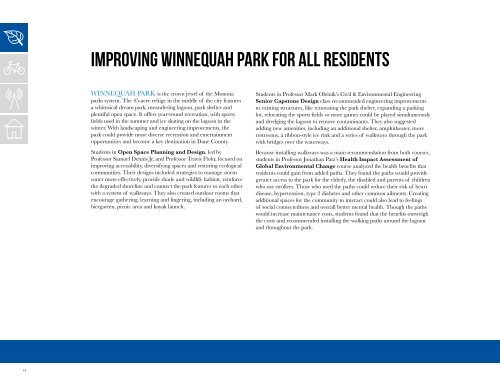UniverCity of Monona
Create successful ePaper yourself
Turn your PDF publications into a flip-book with our unique Google optimized e-Paper software.
Improving Winnequah Park for all residents<br />
Ho-Chunk history and culture in <strong>Monona</strong> parks<br />
WINNEQUAH PARK is the crown jewel <strong>of</strong> the <strong>Monona</strong><br />
parks system. The 45-acre refuge in the middle <strong>of</strong> the city features<br />
a whimsical dream park, meandering lagoon, park shelter and<br />
plentiful open space. It <strong>of</strong>fers year-round recreation, with sports<br />
fields used in the summer and ice skating on the lagoon in the<br />
winter. With landscaping and engineering improvements, the<br />
park could provide more diverse recreation and entertainment<br />
opportunities and become a key destination in Dane County.<br />
Students in Open Space Planning and Design, led by<br />
Pr<strong>of</strong>essor Samuel Dennis Jr. and Pr<strong>of</strong>essor Travis Flohr, focused on<br />
improving accessibility, diversifying spaces and restoring ecological<br />
communities. Their designs included strategies to manage storm<br />
water more effectively, provide shade and wildlife habitat, reinforce<br />
the degraded shoreline and connect the park features to each other<br />
with a system <strong>of</strong> walkways. They also created outdoor rooms that<br />
encourage gathering, learning and lingering, including an orchard,<br />
biergarten, picnic area and kayak launch.<br />
Students in Pr<strong>of</strong>essor Mark Oleinik’s Civil & Environmental Engineering<br />
Senior Capstone Design class recommended engineering improvements<br />
to existing structures, like renovating the park shelter, expanding a parking<br />
lot, relocating the sports fields so more games could be played simultaneously<br />
and dredging the lagoon to remove contaminants. They also suggested<br />
adding new amenities, including an additional shelter, amphitheater, more<br />
restrooms, a ribbon-style ice rink and a series <strong>of</strong> walkways through the park<br />
with bridges over the waterways.<br />
Because installing walkways was a main recommendation from both courses,<br />
students in Pr<strong>of</strong>essor Jonathan Patz’s Health Impact Assessment <strong>of</strong><br />
Global Environmental Change course analyzed the health benefits that<br />
residents could gain from added paths. They found the paths would provide<br />
greater access to the park for the elderly, the disabled and parents <strong>of</strong> children<br />
who use strollers. Those who used the paths could reduce their risk <strong>of</strong> heart<br />
disease, hypertension, type 2 diabetes and other common ailments. Creating<br />
additional spaces for the community to interact could also lead to feelings<br />
<strong>of</strong> social connectedness and overall better mental health. Though the paths<br />
would increase maintenance costs, students found that the benefits outweigh<br />
the costs and recommended installing the walking paths around the lagoon<br />
and throughout the park.<br />
THE HOOCĄK (HO-CHUNK) have occupied the Teejop (Four<br />
Lakes) area for thousands <strong>of</strong> years. Their history is on display in <strong>Monona</strong><br />
parks, which contain several Moš’ok (mounds).<br />
In collaboration with Bill Quackenbush, the Ho-Chunk tribal historic<br />
preservation <strong>of</strong>ficer, students in Pr<strong>of</strong>essor Jessica Conaway’s class, Culture<br />
and Conservation: Living Ho-Chunk History in <strong>Monona</strong> Parks,<br />
produced cultural outreach projects to increase the recognition <strong>of</strong> the Ho-<br />
Chunk Nation, their history and the importance <strong>of</strong> their continued presence<br />
within the <strong>Monona</strong> community. These projects included four lesson plans for<br />
K-5 teachers to instruct students on Native American culture, sovereignty, art,<br />
history, knowledge systems and geography. Students also created educational<br />
signage for Ahuska, Winnequah and Woodland parks, a brochure, website<br />
content and a map depicting the Ho-Chunk’s impact on Dane County.<br />
Rising from the heat<br />
“Fire is an integral part <strong>of</strong> the<br />
natural life cycle <strong>of</strong> an oak savanna<br />
ecosystem, like the one in Woodland<br />
Park. Ho-Chunk People, native to the<br />
<strong>Monona</strong> area, traditionally use fire<br />
ecology to protect medicinal plants<br />
by clearing the adjacent area, and to<br />
firepro<strong>of</strong> areas around settlements,<br />
lessening the risk <strong>of</strong> uncontrolled<br />
wildfires. The Ho-Chunk Department<br />
<strong>of</strong> Natural Resources uses prescribed<br />
burns today to manage their tribal<br />
lands, restoring and maintaining<br />
prairie and savanna ecosystems.<br />
Native oak savanna and prairie<br />
plants have deep roots that survive<br />
these fires and get a head start in<br />
regrowth ahead <strong>of</strong> non-native and<br />
invasive species. Oak trees adapted<br />
specifically to survive fire, with<br />
tough bark that insulates the inner<br />
“cambium” layer which carries food<br />
and water. To this day, Woodland<br />
Park is burned seasonally to maintain<br />
a healthy oak savanna ecosystem.”<br />
The Woodland Trail in Woodland Park guides hikers through a large, oak savanna.<br />
—Students wrote this text for a<br />
proposed sign in Woodland Park<br />
14 15


